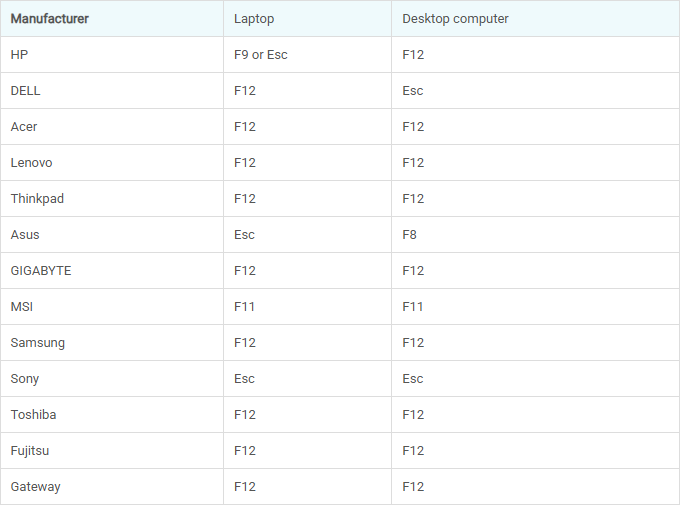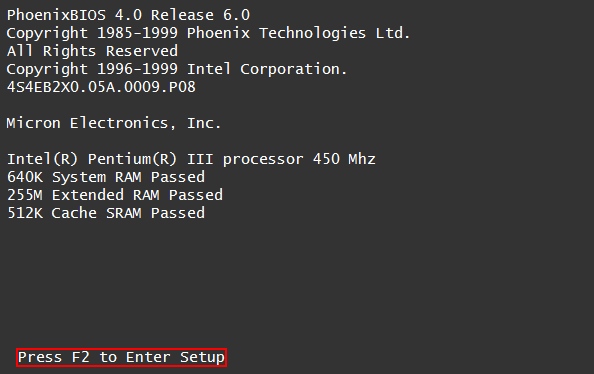How to Set Windows Computer to Boot from USB Drive [Two Ways]
If you're locked out of your Windows computer and need to boot from a USB drive, you may use Boot Menu (newer devices) or BIOS Setup to configure the boot priority.

Blake Sullivan Updated on Mar 21, 2025 4:01 PM

Today, most PCs can boot from USB device so you can run special kinds of software to troubleshoot problems or update software. The computer BIOS Setup Utility allows you to configure the order that the machine searches physical devices (CD-ROM, DVD, Hard drive, or an external USB drive) for the boot sequence. The first device in the order list has the first boot priority.
To boot from a USB device instead of an internal hard drive where you install the operating system, you'll have to move USB device ahead of the hard drive to has boot sequence priority. This tutorial will walk you through on how to boot from a password reset USB drive within a Windows computer (11, 10, 8.1, 8, 7, Vista, XP, Server).
Table of Contents
Option 1: Set computer to boot from USB drive with Boot Menu
Insert the password reset USB drive to computer and power on it. When Vender logo appears, press Boot Menu key (F12 in generally, check Keys for popular PCs in table below) repeatedly to enter Boot Menu, and then choose USB Flash Drive to boot from. If fail to enter Boot Menu (applying for Windows 10 and newer OS) , you can reboot and try again.

Choosing either "USB xx" or "UEFI USB xx" option is OK. Be aware that the interface of Boot Menu may be slightly different on some computers.
Example 1. Set Dell laptop boot from USB flash drive
Insert the password reset USB device and restart the computer. When Dell logo appears, press F12 repeatedly until Boot Menu appears, and then you can select USB flash drive to boot from.
Example 2. Set HP laptop to boot from USB flash drive
Insert the password reset USB Flash drive and start HP computer. When HP Logo appears, press F9 repeatedly until Boot Menu appears, and then choose USB flash drive to boot from.
Note: In some cases, it might be necessary to enable Legacy Support and disable Secure Boot in BIOS in order to boot the computer from USB device.
Example 3. Set Lenovo/ideapad to boot from USB flash drive
Boot Menu Keys for laptops and Desktop computers:

If you fail to boot from USB device using Boot Menu, you can try to boot from a USB device using BIOS Setup, keep on reading.
Option 2: Set Computer to Boot from USB Drive Using BIOS Setup
Basic steps
- Power on locked computer, press the noted key (F2, Del, etc.) on your keyboard to enter BIOS interface. If you don't catch the message the first time, simply restart the machine try again.
- Navigate to Boot tab, then expand Boot Device Priority, it commonly shows a list of devices, such as Floppy, CD-ROM, First Hard Disk etc.
- In First Boot Device, move USB Device to the top of the physical devices list.
- Press F10 to save and exit. You PC will restart and boot from the USB disk.
Visit support pages from different brands
HP PCs - Booting from USB Windows 10: A Comprehensive Guide
Lenovo PCs - Recommended ways to enter BIOS - ThinkPad, ThinkCentre, ThinkStation
Lenovo PCs - Recommended way to enter BIOS - ideapad
Lenovo PCs - Recommended way to enter BIOS for Lenovo Desktops & All-In-Ones - Windows
ASUS PCs - How to Boot from a USB Flash Drive/CD-ROM (Changing Boot Options)
Samsung - Boot your PC with a USB drive or other external media
VAIO laptops - Booting Your VAIO Computer from External Devices
Dell PCs - Booting from a USB stick in general
Example: Set PhoenixBIOS to boot from USB drive
Step 1. Insert the password reset disk to the computer and power on it. Pay close attention to the first screen that appears. You should see something that says "Press [Key] to enter Setup", "Setup =[Key]" or something similar, press that key repeatedly until BIOS Setup screen appears. Here we press F2 to enter PhoenixBIOS.
Tip: In the bottom of the article, we sum up a list of the most common access keys used to enter BIOS Setup on Windows computer.

When you're in the BIOS screen, look for a menu that lets you see and change the boot devices or boot priority. Use the keys given at the bottom/right corner of the screen to navigate through the BIOS. To select something, press Enter.
Step 2. In this example, head to Boot tab, Use +/- key to move Removable Devices to the first order. In most PCs, the USB boot option will show up under one of the following headings: "Hard Disk Drive", "USB HDD", "[USB brand name]" or "Removable Device ", so be sure to dig around if you're having trouble finding the right one to choose.
1. Some PC manufacturers may have different BIOS setup interfaces. Anyway, find the boot order option (it might be called "Boot Device Priority", "Advanced BIOS Features", "First Boot Device", "Boot Sequence") and set the boot priority.
2. Some BIOS may put USB Flash Disk option under Hard Drive. If that's the case, you'll have to expand Hard Drive option, and select USB Flash Disk as the first position in the priority list.

Step 3. Once done, simply press F10 key to save changes you made and exit. Or head to Exit Menu and press Exit Saving Changes (or similar words) to save the settings and exit BIOS.

>> Here are some other common interfaces you might see for setting boot order priority.
Common Keys to Enter BIOS Setup on Windows

Acer - Aspire, Power, Veriton, Extensa, Swift, Ferrari, TravelMate, Predator, Altos, etc.
- Press Del or F2 immediately after powering on.
- The BIOS on the Acer Altos 600 server uses the Ctrl+Alt+Esc key and the F1 key for advanced options.
- Older Acer computers may also use the F1 or Ctrl+Alt+Esc keys to access BIOS.

ASUS - VivoBook, Zen AiO, Zenbook, B, S, Q, V, X, K, T, U series, etc.
- Press F8 repeatedly to enter BIOS > Advanced Boot Option.
- Press F2 repeatedly to start the BIOS setup utility.
- Some Asus laptops might use Del, Esc, or F10 key.
- Older ASUS computers may required you to press the ESC key until Boot Device Selection screen appears, then select Enter Setup from the menu.

HP - Pavilion, TouchSmart, Pro, Vectra, Stream, Vectra, OMEN, ENVY, OmniBook, EliteBook, ProBook, Zbook, Tablet
- Press the F1, F10, or F11 key until you see the BIOS screen.
- HP Tablet PCs may use F10 or F12.
- Other HP computers may allow access to BIOS using the F2 or Esc keys.
- Some of old PCs might require that you press the Esc key and then F10.

Lenovo (formerly IBM) - ThinkPad, IdeaPad, Yoga, 3000 Series, Legion, ThinkCentre, ThinkStation, H535, 3000 Series, N Series, etc.
- Press F1 or F2 after powering on the computer.
- Press F12 to access BIOS.
- Some Lenovo laptop have a small Novo button on the side (next to the power button), press and hold it to enter the BIOS setup utility.
- Older PCs may use Ctrl+Alt+F3, Ctrl+Alt+Ins, or Fn+F1.

Dell - XPS, Dimension, Inspiron, Latitude. OptiPlex, Precision, Alienware, Vostro
- Press F2 when the Dell logo appears. Press every few seconds until the message Entering Setup appears.
- Older Dell desktops and laptops may instead use Ctrl+Alt+Enter or Del to enter BIOS.
- Older Dell laptops may use Fn+Esc or Fn+F1.

Shuttle - Glamor G-Series, D'vo, Prima P2-Series, Workstation, XPC, Surveillance
- Press F2 or Del on startup.

Sony - VAIO, PCG-Series, VGN-Series
- Press F1, F2 or F3 after turning on the computer.

Samsung - Notebook, ATIV Book, ATIV One, ArtPC PULSE, etc.
- Press F2 key after turning on the computer.

Toshiba - Portégé, Satellite, Tecra, Equium
- Press F1 or Esc after powering on to access BIOS.
- Press F12 on a Toshiba Equium.

Compaq - Presario, Prolinea, Deskpro, Systempro, Portable
- Press F10 while the cursor in the top right corner of the screen is blinking.
- Older Compaq computers may use the F1, F2, F10, or Del key to enter BIOS.

eMachines - eMonster, eTower, eOne, S-Series, T-Series
- Press Tab or Del while the eMachine logo displays on screen.
- Other eMachine computers may use F2 to enter BIOS.

Fujitsu - LifeBook, Esprimo, Amilo, Tablet, DeskPower, Celsius
- Press F2 once the Fujitsu logo appears.

Gateway - DX, FX, One, LT, GM, NE, GT, GX, NV, Profile, ONE, SX, Astro
- Press the F1 or F2 key repeatedly after restarting the computer.

IBM - PC, XT, AT
- Press F1 immediately after powering on the computer.
- Older IBM computers may utilize the F2 key for BIOS entry.

Micron (MPC Computers) - ClientPro, TransPort
- Press F1, F2 or Del immediately after powering on the PC.

NEC - PowerMate, Versa, W-Series
- Press F2 to enter the BIOS Setup.

Packard Bell - 8900 Series, 9000 Series, Pulsar, Platinum, EasyNote, imedia, iextreme
- Press F1, F2, or Del to enter BIOS.

Sharp - Notebook Laptops, Actius UltraLite
- Press F2 after the computer starts.
- Some very old Sharp PCs require a Setup Diagnostics Disk to access BIOS.

EVGA - SC17, SC15
- Press Del repeatedly to access BIOS Setup



















